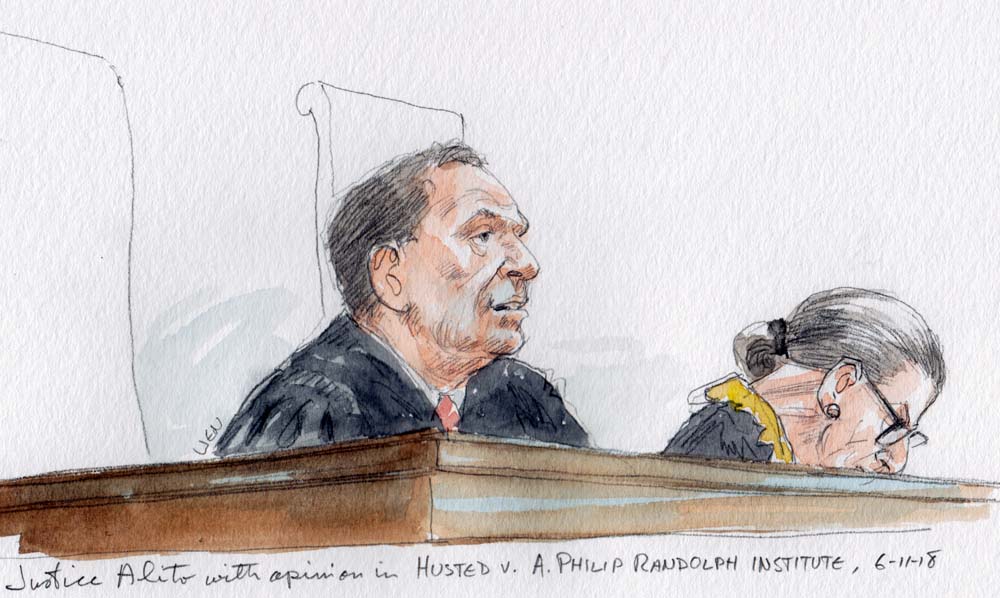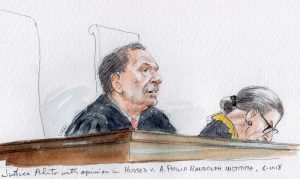Opinion analysis: Justices rule for Ohio in voter-registration dispute (Updated)

on Jun 11, 2018 at 3:58 pm

[NOTE: This post, originally published at 11:45 a.m., was updated with additional analysis at 12:58 p.m.]
The Supreme Court today rejected a challenge to one of the practices used by Ohio to remove voters from the state’s voter rolls. By a vote of 5-4, the justices agreed that the practice under question – which cancels the registration of voters who do not go to the polls and who then fail to respond to a notice – does not violate federal laws governing voter registration. The decision could mean that more states will adopt similar laws to trim their voter rolls, particularly when (as the majority observed today) roughly one in eight voter registrations is “either invalid or significantly inaccurate.” Justice Sonia Sotomayor criticized the ruling in her dissent today, predicting that it could have a disproportionate effect on the poor, the elderly and minorities.
The case arose when U.S. Navy veteran Larry Harmon went to his local polling place in Ohio to vote in 2015. Harmon learned that, although he had lived in the same place for more than 16 years, he had been removed from the voter rolls because he had not voted in 2009 and 2010 and then also had not responded – because he said he didn’t remember receiving it – to a notice that the state elections board had sent him in 2011 to confirm his eligibility.
Harmon and Ohio civil rights groups went to court, arguing that Ohio’s practice conflicted with two federal voting laws. The first law, the National Voter Registration Act, was enacted in 1993 to advance two goals: Making it easier for would-be voters to register while at the same time guaranteeing “accurate and current” registration lists. The second law, the 2002 Help America Vote Act, directed the states to maintain a system to cull ineligible voters from their lists. Congress indicated that states can remove voters “who have not responded to a notice and who have not voted in 2 consecutive” federal elections, but it added that “no registrant may be removed solely by reason of a failure to vote.”
In a decision by Justice Samuel Alito, the court emphasized that subsection (d) of the NVRA specifically allows states to remove a voter who “has failed to respond to a notice” and “has not voted or appeared to vote.” Indeed, the majority stressed, not only “are States allowed to remove registrants who satisfy these requirements, but federal law makes this removal mandatory.” The Ohio practice at issue in this case, the majority concluded, “follows subsection (d) to the letter”: “It is undisputed that Ohio does not remove a registrant on change-of-residence grounds unless the registrant is sent and fails to mail back a return card and then fails to vote for an additional four years.”
For the five justices in the majority – Alito, along with Chief Justice John Roberts and Justices Anthony Kennedy, Clarence Thomas and Neil Gorsuch – the extent to which Ohio’s practice hews to subsection (d) was enough. And they rejected the challengers’ argument that the state’s practice violates the ban on removing voters from the registration lists “solely by reason of a failure to vote” because it uses the failure to vote as the trigger for sending the return card. The majority reasoned that Ohio’s practice would violate the “failure-to-vote” clause “only if it removes registrants for no reason other than their failure to vote.” But here, the majority reiterated, the state “removes registrants only if they have failed to vote and have failed to respond to a notice.”
Justice Stephen Breyer dissented from today’s decision, in an opinion joined by Sotomayor and Justices Ruth Bader Ginsburg and Elena Kagan. Breyer would have struck down Ohio’s practice not only because it violates the provision prohibiting states from removing voters from their list “solely by reason of a failure to vote,” but also because he believes that Ohio is not complying with its obligation, under the same federal laws, to make a “reasonable effort” to remove ineligible voters from its lists. Breyer complained that the state reads too much into a voter’s failure to return a notice to confirm his eligibility. There is no reason to assume such voters have moved, Breyer suggested; for whatever reason, he posited, it’s simply human nature that people don’t return cards that they get in the mail.
Alito pushed back against the Breyer dissent, criticizing its reliance on its “own cobbled-together statistics” and “a feature of human nature of which the dissent has apparently taken judicial notice.” Breyer may not think that a voter’s failure to confirm his eligibility by taking what Alito characterized as “the simple and easy step of mailing back the preaddressed, postage prepaid card” or updating his information online has any significance, Alito wrote, but Congress disagreed. What Breyer’s dissent really boils down to, said Alito, is a “policy disagreement.” But this case is about interpreting federal statutes, Alito emphasized: “We have no authority to second-guess Congress” or to decide whether Ohio’s practice is the best way to keep its voter rolls current. “The only question before us,” Alito concluded, is whether the practice “violates federal law. It does not.”
The strongest objections to today’s ruling came from Sotomayor, who wrote alone to complain that the court’s opinion “entirely ignores the history of voter suppression against which the NVRA was enacted and upholds a program that appears to further the very disenfranchisement of minority and low-income voters that Congress set out to eradicate.” Sotomayor pointed to a “friend of the court” brief filed in the case indicating that “African-American-majority neighborhoods in downtown Cincinnati had 10% of their voters removed due to inactivity” in the last few years, as “compared to only 4% of voters in a suburban, majority-white neighborhood.” Moreover, she added, most states have found a way to keep their voter-registration lists accurate without relying on the failure to vote as a trigger for their schemes. “Today’s decision,” Sotomayor concluded, “forces these communities and their allies to be even more proactive and vigilant in holding their States accountable and working to dismantle the obstacles they face in exercising the fundamental right to vote.”
Alito was equally dismissive of the Sotomayor dissent. He observed that the dissent “says nothing about what is relevant in this case,” because no one had argued that the practice ran afoul of a provision in the NVRA barring discriminatory state programs; indeed, he noted, Sotomayor had not actually “pointed to any evidence in the record that Ohio instituted or has carried out its program with discriminatory intent.” Strong words again, but almost certainly not the last ones we will see at the Supreme Court this month.
This post was originally published at Howe on the Court.



